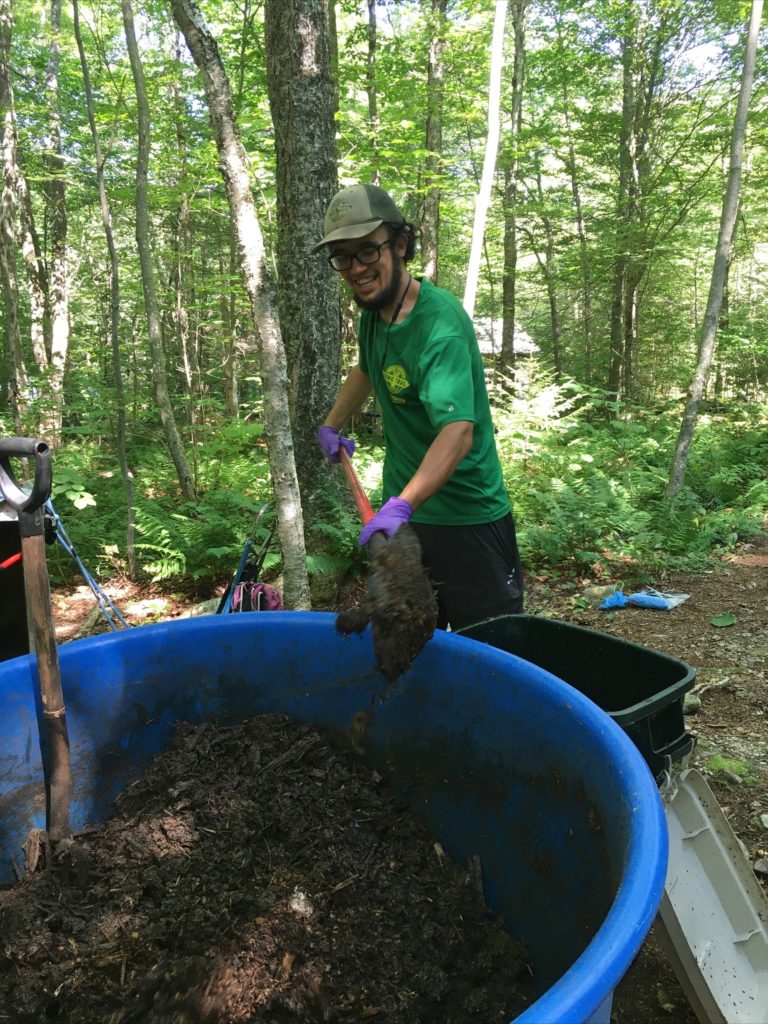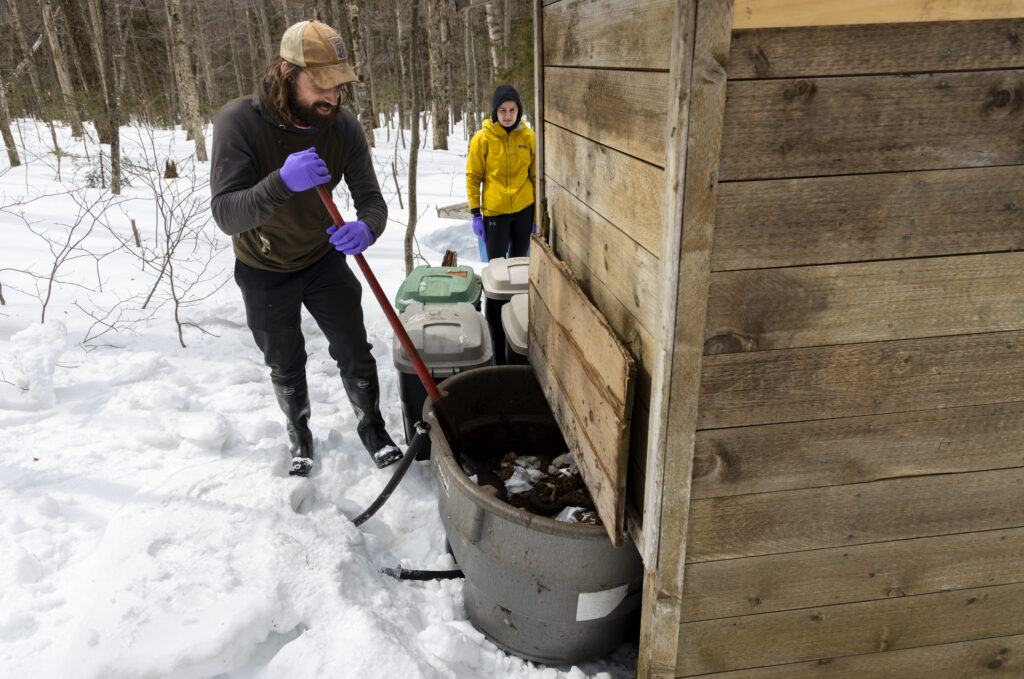On an overcast morning in late March, several members of the Green Mountain Club’s full-time field programs staff took a two mile hike to Little Rock Pond for some post-winter, pre-hiking season “fun”: visiting the shelter site’s composting privy to perform some maintenance before hiking season begins in June.
View this post on Instagram
GMC uses three main types of privies: the pit privy (which is being phased out), the moldering privy, and the composting privy. At high-usage sites like Little Rock Pond, which is located on the LT/AT near Wallingford, you’ll find batch-bin composting privies which use a relatively fast hot composting process to manage human waste.
Human excrement is an unavoidable part of backcountry hiking and camping and a major component of GMC’s trail system management duties. Having a way to sustainably manage how hikers go #1 and #2 while on the Long Trail is an important part of keeping the Long Trail an enjoyable public resource, and limiting impact on the surrounding environment.
So how do composting privies work? And what goes into maintaining one?
The Composting Privy Process:
From Seat to Catcher
A batch-bin composting privy looks pretty much like any other outhouse, a small wooden structure built for some privacy with a toilet seat inside. Underneath is a large catcher container to collect all the waste. It’s best to pee in the woods before using the privy, as composting privies process solid waste and aren’t as efficient if there’s too much liquid content. This is usually indicated with a sign on the privy door to help hikers use the privy responsibly.
Once the catcher fills up, a GMC backcountry caretaker removes it from under the seat by pulling it out of the back of the privy. The contents are emptied into storage cans until enough material has accumulated to be transferred to the large batch-bin for the hot composting process to begin.
Into the Batch-Bin
 The waste is mixed with bark mulch to both add bulk and to help achieve the right carbon and nitrogen balance. Within about a week’s time, the pile in the batch-bin will reach a temperature of between 160º and 180ºF, setting rapid decomposition into motion. The temperature falls after this spike, so the caretaker gives the pile a stir to allow the temperature to spike again. For the next six to eight weeks, the caretaker stirs the pile every few days to keep the temperature-spike-and-fall cycle going.
The waste is mixed with bark mulch to both add bulk and to help achieve the right carbon and nitrogen balance. Within about a week’s time, the pile in the batch-bin will reach a temperature of between 160º and 180ºF, setting rapid decomposition into motion. The temperature falls after this spike, so the caretaker gives the pile a stir to allow the temperature to spike again. For the next six to eight weeks, the caretaker stirs the pile every few days to keep the temperature-spike-and-fall cycle going.
Last Step: Rest
After six to eight weeks of the spike, fall, and stir cycle, the compost is nearly pathogen-free. It’s then transferred to a drying rack to sit for a few more months until it is completely pathogen-free and safe to disperse in the woods around the privy.
What’s the difference?
Batch-bin composting privies are just one of three types of privies in use on the Long Trail system, the other two being moldering and pit privies. So, what’s the difference between them?
Moldering privies are a slower version of the batch-bin composting privy that also requires less upkeep and labor. There’s no transfer to storage cans or batch bins; the decomposition occurs in the chamber right underneath the privy. Wood shavings are thrown in with waste and it slowly decomposes on its own without the need for the stirring and mixing that caretakers are needed for with the composters. And unlike the composting privy, moisture is necessary for the decomposition process, so peeing is ok at moldering privies. The whole decomposition process takes about five years, which is why moldering privies are found at lower use sites.
Pit privies are relics from before the 70s hiking boom and the resulting development of more sustainable waste management systems. There are currently only three pit privies remaining in the Long Trail system, with the goal to have the last one converted to a moldering privy by 2024 (fingers crossed). Pit privies are exactly what they sound like – a poor-smelling hole in the ground that fills up with waste. When filled, trail maintainers cover them up and dig a new pit, leaving the waste to decompose directly into the soil. With the increase in backcountry recreation, this method is no longer sustainable and some sites are running out of places to dig new pits.
Thank You Composters, Thank You Caretakers
Next time you’re on the Long Trail and come across one of the many privies, you’ll know what work goes into maintaining them. For the composters especially, you’ll cast your eye around to identify the batch bin and drying rack and know the time and effort it takes to keep them functional. And you may have an extra amount of awe and gratitude for the caretakers who make it all happen.




















I was caretaker at little Rock pond in 1974 when the first clivis composting toilet was installed. after that part of my job was to take up leaves to add balance to the compost. Happy that since it was so new shoveling out the product was not a job. I’ve often wondered how long the big fiberglass tank lasted out in the open like it was installed.